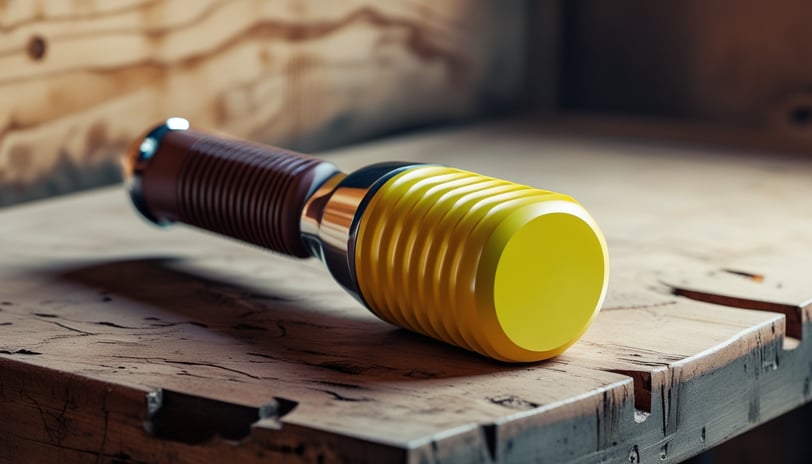Essential Guide: Why is a rubber mallet often used in woodworking
Discover why is a rubber mallet often used in woodworking. Learn its unique features, different types, practical tips, and step-by-step guidance on how to use it effectively for achieving perfect project results every time.


Essential Guide: The Versatility of Rubber Mallets in Woodworking
Woodworking is a delicate craft that requires precision, patience, and the right tools. Among these tools, the rubber mallet often stands out as a silent hero in the workshop. Whether you're assembling tight joints, carving intricate details, or renovating vintage furniture, the rubber mallet is essential for countless tasks. But why is a rubber mallet often used in woodworking, and what makes it so indispensable?
This guide explores the unique features and uses of the rubber mallet, provides practical tips for choosing and using one, and dives into real-life examples of its impact in woodworking projects.
What Makes the Rubber Mallet a Woodworking Essential?
Rubber mallets have a basic yet effective design—a soft rubber head attached to an ergonomic handle, usually made of wood, fiberglass, or metal. Their defining feature is their ability to apply force without causing damage. Unlike metal hammers that can leave dents or scratches, rubber mallets distribute force evenly through their non-marring rubber head.
This makes them ideal for working with delicate materials like wood, marble, or laminate during DIY wood projects and professional carpentry. They ensure precision while protecting your material’s integrity—something invaluable to the craft of woodworking.
The Unique Features of a Rubber Mallet for Woodworking
Non-Marring Properties
One of the rubber mallet’s standout qualities is its soft, non-abrasive head. This ensures that force can be applied to delicate wooden surfaces without causing blemishes or damage. If you’ve wondered, “Can marble and wood work together in certain mixed-material projects?”, the rubber mallet is ideal for ensuring compatibility without any scuffs.
Controlled Force
The malleable rubber absorbs some of the impact, making it easier to control the force applied. This is especially helpful when you need accuracy in tight-fitting joints for easy wood projects or detailed carvings.
Versatility Across Materials
Not just limited to woodworking, rubber mallets are also effective for tasks incorporating marble, metal, or laminate. Their adaptability makes them a favorite for both DIY enthusiasts and professional carpenters.
Types of Rubber Mallets and Their Applications
Not all rubber mallets are created equal. Here are some specialized types used in woodworking and their specific applications:
1. Standard Rubber Mallets
These are versatile and work well for general woodworking tasks like assembling furniture or flooring installation. Their soft head makes them ideal for beginners tackling easy wood projects.
2. Dead Blow Mallets
Designed to minimize recoil, dead blow mallets deliver more controlled force. These are perfect for projects requiring higher precision, such as assembling tight joints in timber framing or intricate wood sculptures.
3. Carving Mallets
Specifically designed for detailed woodworking, carving mallets are slightly heavier with a rounded head, allowing for greater precision in shaping and refining wood.
4. Specialized Mallets for Mixed Materials
Some mallets are designed to work with materials like marble and wood, making them perfect for projects combining different surfaces.
How to Choose the Right Rubber Mallet for Your Project
Selecting the right mallet depends on the nature of your project. Here’s a helpful guide:
1. Consider the Material
If you’re using softwoods or delicate materials, opt for a lightweight mallet with a softer rubber head. For hardwood and heavy-duty tasks, dead blow mallets work best.
2. Handle Material
Handles come in wood, fiberglass, or metal. While wooden handles provide a classic feel, fiberglass handles absorb vibrations efficiently, offering better control.
3. Weight and Size
A lighter mallet is ideal for small crafting projects, while heavier mallets provide the force needed for larger tasks like flooring installation.
4. Budget and Durability
Invest in a durable mallet if you’re a professional carpenter or frequent DIYer. High-quality mallets may cost more but ensure longevity and reliable performance.
Real-Life Applications of Rubber Mallets in Woodworking
1. Building Custom Bookshelves
A DIY enthusiast shared their experience assembling bookshelves using a rubber mallet. The tool helped align tight-fitting joints without leaving dents.
2. Carving a Wooden Figurine
A professional sculptor used a rubber mallet to refine detailed carvings without damaging the wood’s delicate surface. The mallet’s non-marring qualities ensured the carving's intricate details remained intact.
3. Restoring a Vintage Chair
During a restoration project, a rubber mallet played a crucial role in disassembling and reassembling a vintage chair. Its surface-protecting properties preserved the chair's original finish.
4. Installing Hardwood Floors
A flooring company documented their use of rubber mallets to tap planks into place during installation. The mallets ensured a tight, seamless fit without any surface scratches.
Techniques for Using a Rubber Mallet Safely and Effectively
1. Test on Scrap Wood
Before starting, test your mallet on a scrap piece of wood to understand its impact.
2. Use Controlled Force
Start with gentle taps and gradually increase force as needed. This ensures you don’t introduce unintended damage.
3. Keep the Mallet Clean
Clean your mallet regularly to prevent residue transfer onto your wood.
4. Grip Properly
Hold the mallet securely with both hands for better control and accuracy.
5. Store Correctly
Store your rubber mallet in a dry, cool area to maintain its non-marring head and durability.
Why Every Woodworker Should Own a Rubber Mallet
Whether you're assembling intricate joints, refining carvings, or restoring vintage furniture, the rubber mallet is an irreplaceable tool for any woodworking enthusiast. Its unique ability to apply precise force while protecting delicate surfaces makes it both reliable and versatile.
Want to streamline your projects with the right tools? Subscribe now for more woodworking tips, or visit our store to explore mallets and other essentials designed for every wood project.
Explore
Crafting beautiful woodworking projects for everyone.
Contact us
7217503970
© 2024. All rights reserved.
official@discodigit.in
